Like last month, this article highlights clouds – but with a twist. Thanks to its irregular shape, Bainbridge Island has lots of picturesque harbors, bays, and inlets – and when you combine clouds with calm, tranquil waters at the right time of day, wonderful reflections are often the result. So this time, instead of just focusing on clouds in the sky, we will point the camera downward a little bit while showing off different parts of the island, including Eagle Harbor, Port Madison, Port Blakely, and the Sandspit.
So let’s start with reflections on reflections. Specifically, what exactly causes them in the first place? To hopefully answer this question, I consulted an internet article published by Physics Stack Exchange:
The most fundamental answer is that water reflects light because the wave impedance of water is different than the one of air and the electric and magnetic field must be continuous everywhere in space.
The important thing to note is that the wave impedance is the fixed ratio of the electric and magnetic field amplitude of the light wave and that the electric field and magnetic field must be continuous, i.e. cannot change their value discontinuously at material boundaries.
This is a direct consequence from Maxwells Equations, the fundamental equations describing the propagation of light.
Okay, let’s be honest. Speaking only for myself, this physics mumbo jumbo nearly fried my brain. Wave impedance of water? Electric and magnetic fields? Maxwell’s Equations? I didn’t know Maxwell had any equations, let alone more than one.
With noggin still hurting, I decided to shift gears by skipping the physics stuff and checking out what photography articles had to say about reflections. Here is one tidbit that I found:
Using reflection in photography can lead to some amazing effects and beautiful images. Using water, windows, mirrors or any sort of reflective surface can change an image into a work of art. The wonderful thing about using reflections when taking photos is that they can completely alter the image from something fairly straightforward to something richer or abstract or otherwise more artistic.
Hmm. While I agree with all of this, it doesn’t tell me anything I didn’t already know, let alone explain in simple, understandable terms what exactly causes reflections. On second thought, maybe it’s time to just forge ahead with the images and (maybe) get educated down the road about the science underlying reflections.
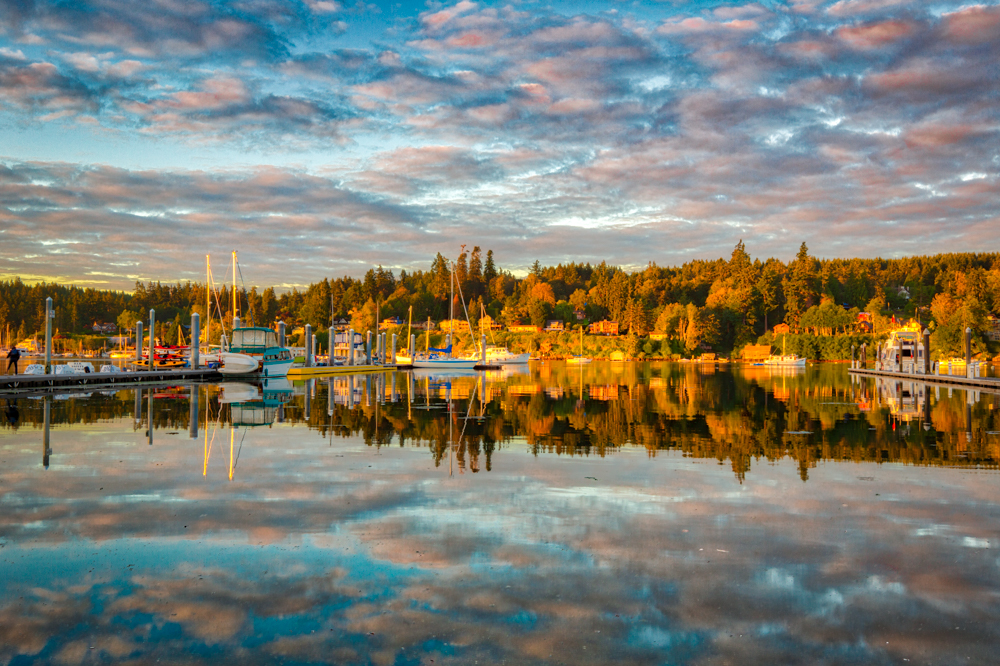
In my last article, I identified the 10 principal cloud types and explained how they are grouped based on whether they are low-level, middle, or high-level clouds. Unfortunately, that short lesson in cloudology exhausted my limited knowledge of meteorology, and I’m just not sure what type of cloud is present in the above image. I want to say stratocumulus, but that’s admittedly just a guess. What I can positively tell you, however, is that I took this shot from the beach at Eagle Harbor Waterfront Park in the month of July shortly after sunrise. The exact time was 5:38 a.m., so I had the place completely to myself. Well, almost to myself, as there’s the one person to the far left standing on the public dock (which, by the way, is a whopping 900 feet long!). This image is a great example of the so-called “golden hour,” which is the period of daytime immediately after sunrise when the light is warmer and softer. When combined with little to no wind, resulting in the glassiness of the water surface, you have the perfect combination for a reflection shot!
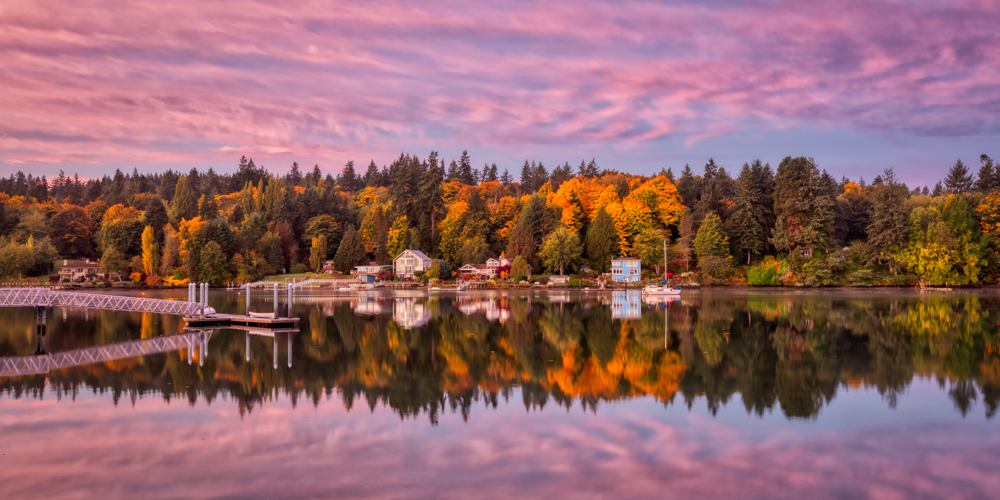
It’s been estimated that Bainbridge Island has approximately 53 miles of coastline, much of which is privately owned. But happily, significant public access to the shoreline is available through public parks – the 1,100 feet of waterfront at Fay Bainbridge Park come to mind – and through road ends. If you’re not familiar with that term, road ends are typically narrow rights-of-way or easements which extend from the end of a road to a water view or to a water access point. These rights-of-way are owned and managed by the City of Bainbridge Island and, in some cases, our local Parks District. There are over 60 road ends on the island, though most sites don’t accommodate parking and are therefore best suited to pedestrian access. As explained online at a wonderful COBI website which also contains a road ends map, several served as landings for the historic Mosquito Fleet steamers which ran between the 1870s and the 1930s when Bainbridge Island was inaccessible by car. (In case you’re wondering, the Agate Pass Bridge didn’t open until 1950.)
So why am I educating you about our local road ends? Because the above image was obtained from a site officially designated as “Lovell Avenue SW Road End #16” just a short distance west of Winslow. (Go west on Winslow Way until it dead ends at Lovell Avenue and make a left; there is some street parking nearby.) It was shot five minutes before sunrise last October, which accounts for the pinks in the sky above the south side of Eagle Harbor. Note once again the calmness of the water – and yes, we do have a distinct trend developing in this month’s images.
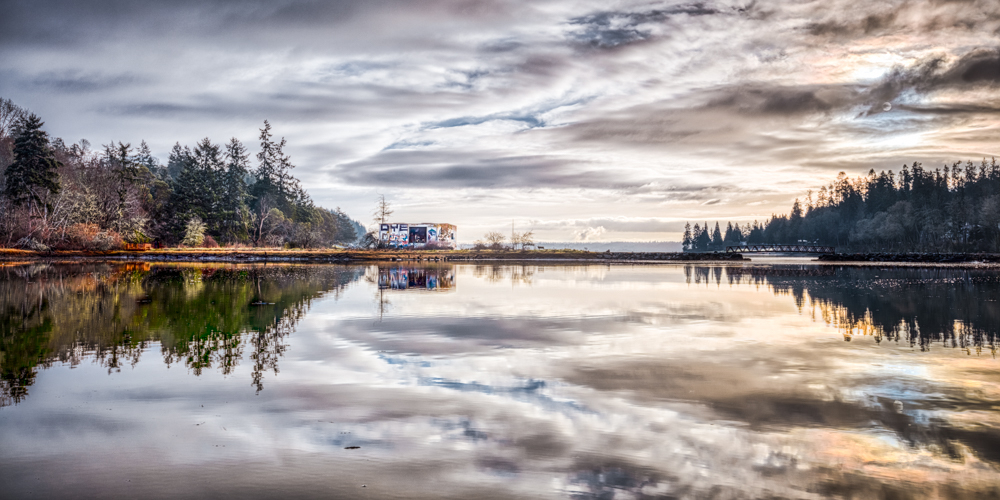
Port Blakely is a thing of natural beauty, a picturesque harbor tucked away in the southeastern portion of the island. But let’s go back in time over 156 years to June 30, 1863. That’s when Captain William Renton, a lumber and shipping merchant originally from San Francisco, used the federal Donation Land Act to buy 164.5 acres in Port Blakely for a total investment of $205.63. A real mover and a shaker, Renton bought the land to relocate his sawmill business, which he had up and running in Port Blakely by April 1864. The mill’s lumber production was small at first – just 20,000-30,000 board feet per day – but eventually grew to an impressive peak capacity of 500,000 board feet per day. The mill’s success caught the eye of Hall Brothers, a local shipbuilding company, which moved its location to Port Blakely in 1880. The first vessel built there – a 365-ton, three-masted schooner named Maria Smith – was launched on May 1, 1881. This arrangement was a huge financial coup for Renton, who sold lumber to his next-door neighbor whose ships then transported his lumber as cargo to ports around the world.
The sawmill needed infrastructure for its booming enterprise, so a town soon arose in Port Blakely. At its peak, the village included a post office, company store, livery stable, 75-room hotel, and a jail. Renton also built homes for workers’ families, dormitories for the bachelors, and a house for himself near the mill pond used as a holding area for logs destined for the sawblade. Two devastating fires – one in 1888 and the other in 1907 – burned the sawmill to the ground, but it was immediately rebuilt both times. Changing economic circumstances eventually took their toll, however, resulting in the closure and demolition of the mill in 1922.
So let’s fast forward 100 years. As shown by the above image, Mother Nature has done an incredible job of reclaiming Port Blakely over the past century. The lone vestige of the sawmill is the old boiler house, now just a concrete pillbox decorated with graffiti. The photograph gets its name from the footbridge installed in April 2021. The new jetty bridge is 65 feet long and weighs 3,800 pounds.
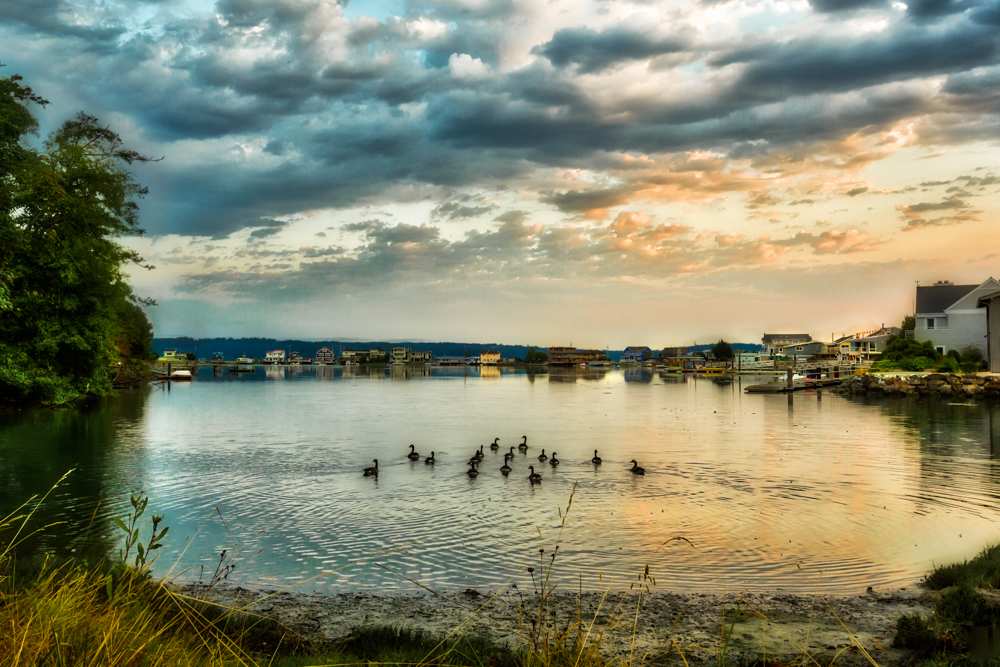
Though relatively small – roughly five miles wide and 10 miles long – Bainbridge Island has many unique neighborhoods. One of them would certainly be Point Monroe, which is located on the northeastern end of the island just north of Fay Bainbridge Park. For those not in the know, Point Monroe – also known as “the Sandspit” – is a thin strip of land that wraps around a saltwater lagoon and provides no-bank waterfront for approximately 50 homes.
The above image is another “crack-of-dawn” effort where I had to crawl out of bed at some ungodly hour to make sure I arrived sufficiently before sunrise. The pinks, oranges, and blues in the sky were all shaping up quite nicely when I noticed a gaggle of geese swimming towards me on the left side of the lagoon. Since they were an unwanted distraction, I decided to wait until the geese were outside my camera’s field of view. Instead, to my great chagrin, the @!#$% birds changed course and swam to the exposed shore right in front of me, whereupon – in no obvious hurry – they began looking for food in the wet muck. Meanwhile, I’m stressing out because time is a-fleeting and I’m about to lose my morning colors. The geese must’ve read my mind because just after I decided to try some not-so-friendly persuasion by hurling some hard objects their way, they suddenly – and in complete unison – all entered the water and started swimming toward the middle of the lagoon. While it wasn’t quite the cloud reflection shot I had in mind, between the pattern of their grouping and the ripples caused by their movement, the overall composition was still acceptable.
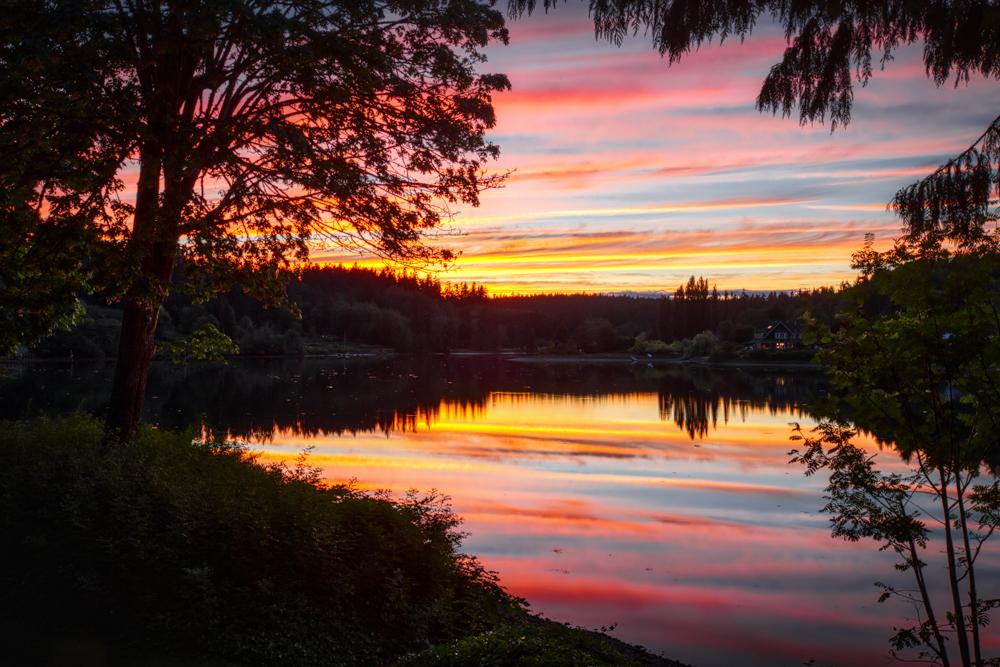
We’ve got a plethora of different images at our gallery, so we need to give each one a unique title – partly to remember which one is which but also to maintain an accurate inventory. Assigning unique numbers won’t do because except for cell phone and maybe Social Security numbers, nobody remembers them. Plus, numbers aren’t evocative and have no aesthetic appeal. Consequently, we give each image a name, but sometimes it can be challenging to pick one that fits.
So why “Neapolitan” for the above exposure depicting a fiery sunset over the westerly end of Eagle Harbor? Fair question – and truthfully, there might not be a very good answer. Webster’s Dictionary says “Neapolitan” refers to a resident of Naples, Italy, so that’s obviously off the mark, while the colors in the sky are certainly more variegated than those found in a gallon of Neapolitan ice cream. All I know is, one can have only so many images called “Sunset over Eagle Harbor,” so since “Neapolitan” for whatever reason was the first word that came to my mind, we’ll leave it at that at least for now.
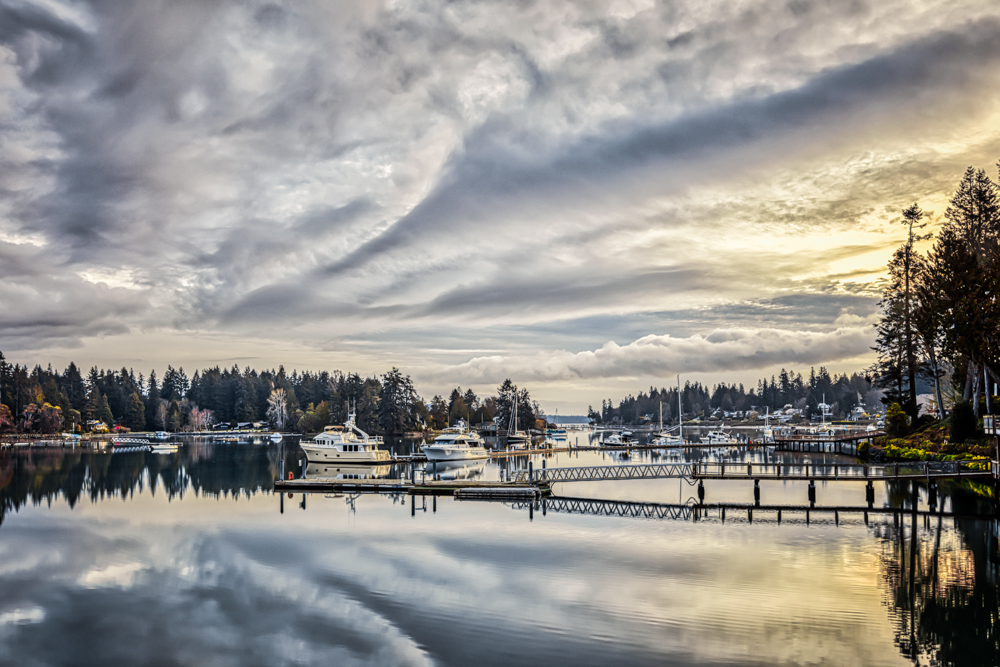
A little over a year ago, I decided to attack the day early and see what was going on at the Sandspit. The night before The Weather Channel had predicted “partly cloudy” in the morning, which is almost always a prerequisite for setting the alarm early. (If either “clear” or “cloudy” are forecast, I’ll invariably take a pass.) When I got there, the good news was that virtually no geese were in sight. The sky and clouds weren’t very inspiring, however, so I decided to dash over to Hidden Cove Park, which is one of my other go-to spots on the northeast portion of Bainbridge Island. The park has a beautiful water view, as well as a relatively new 220-foot-long dock, on the south shore of Port Madison. This time the weather gods weren’t so fickle because although I missed out on the pre-sunrise pinks, the unique cloud formations – let’s guess stratus this time? – in combination with the placid waters of Port Madison made for a lovely composition.
So why call this image “Funnelstreams”? Because like “Neapolitan,” it was the first thing that came to my mind – and I thought it was catchy and somehow matched up to the longish, tube-like clouds. The important thing is, if a customer asks me whether I’ve got a matted print of “Funnelstreams” in a different size, I’ll know exactly what image they’re talking about!
Bergh Images
Facebook – Instagram – Website
NEXT MONTH: Decisions, decisions. With ferries and clouds now out of the way, we still have lots of possibilities for my next article. It’s too early for fall colors, but that still leaves plenty of options. Speaking of “leaves,” maybe something consistent with the fact that spring recently sprung? Thankfully, plenty of time to decide before my next publishing deadline.
PREVIOUS ARTICLES:
Island Images Volume #3
Island Images Volume #2
Island Images with Andrew (“Andy”) Bergh

ABOUT ANDREW BERGH: Local artist Andrew (“Andy”) Bergh is a long-time Bainbridge Islander (33+ years), whose successful transition from law to photography began in 2010. After displaying his unique and evocative images at different venues, including the Bainbridge Island Studio Tours, the Saturday Farmers Market, and various local businesses, Andy took the big plunge in September 2018 when he opened his own gallery – Bergh Images – in downtown Winslow. His prints are offered in different mediums, including metal, canvas, and fine art acrylic prints; matted prints; and custom-framed black and white prints. Andy has an online presence at https://berghimages.com/, which also features his entertaining travel blog. The gallery is open every day but Monday, with Andy and his wife Carol regularly participating in the monthly First Friday Art Walks sponsored by the Bainbridge Island Downtown Association.
Facebook – Instagram – Website